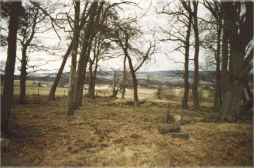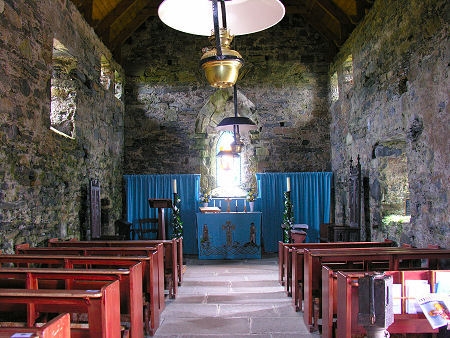St Moluag of Lismore
Died: 592AD
Also known as Lugaidh and Molloch, Moluag was born c.530AD of the clan Dál nAraidhe, in northern Ireland. Many consider his true name to have been Lugaidh (pronounced Lua) and the form 'Moluag', as used in the Annals of Tigernach, is simply an affectionate form - Mo-Luoc, "my Lugaidh". According to one tradition, he was a disciple of St Brendan of Confert; according to another, of St Congal of Bangor. Leaving Ireland he crossed to Lismore in Argyll, the principal locus of his cultus in Scotland. St Moluag's plan for working Pictland was to organize three great muinntirs or communities to be the centres of education and ministerial supply for the Churches in their respective districts; and, of course, for the maintenance of these central communities he had the reserves of the mother church of Bangor in Eire at his disposal.

Above: Site of St Moluag's 'muinntir' at Clova, Aberdeenshire.
He first organised the great community of Lismore in Lorn, c.562AD. Moluag's settlement was in the north of the island of Lismore, close to a megalithic site surmounted by a high cairn which once marked the funeral pyres of Pictish Kings. This island was the sacred island of the Western Picts, and continued to be the burial-place of their kings who reigned at Beregonium. The Churches dependent on Lismore, which are still traceable, are Teampul Mór in Lewis; the Church of Pabay, that is, Isle of the pápa; Cill Moluag in Raasay; Teampull Mholuig, "Moluag's Chapel", at Eoropie in Ness; Cill Moluag in Skye; Cill Moluag in Tiree; Cill Moluag in Mull; Kilmalu in Morvern; Kilmalu of Inverary; and Cill Moluag at Ballagan, Inverfarigaig.
St Moluag's second central community is said to have been organised at Rosemarkie on the northern shore of the Inverness Firth (however, see below). Many of the churches founded from this centre were afterwards, in the Roman Catholic period, dedicated to Roman saints, and they cannot now be definitely distinguished as St Moluag's; but there was an old church in the strath of the Peffray (Strathpeffer) whose temporalities are still called Davoch-Moluag, and the submerged Church of Cromarty was evidently one of St Moluag's foundations.
His third central community was at Mortlach in Morayshire. Dependant upon it was the smaller community at Clova or Cloveth near Lumsden village. The
foundations that still bear St Moluag's name in this part of
Scotland are at "Maol-Moluag's" - now New
Machar, at Clatt in the Garioch and Tarland. Also, scholars have recently become comfortable with the idea that the old parish church of St Andrews, near Elgin, in the diocese of Moray
St Moluag continued to labour in Pictland until his death on the 25th June 592 AD. Some sources say that he died at Ardclach in Nairnshire and his body was carried back to Lismore. According to other old traditions he died while visiting his churches in the Garioch and was buried at Rosemarkie. In the Martyrology of Oengus, under his entry on June 25th, is a comment which is typical of the warm esteem with which he is commemorated in the Irish calendars:
"The pure, the bright, the pleasant,
the sun of Lismore;
that is Moluoc,
of Lismore in Alba".
St Moluag's crozier, known as the Bacchuill Mór, "the great staff", a piece of blackthorn 34 inches long and originally covered in a gilded copper case, was preserved on Lismore, in Bachuil village. It was in the care of the Livingstone family after having been, for some time, in the custody of the Dukes of Argyll. Because of their associations with the Bacchuill Mhór this Livingstone family still holds the ancient title of Barons of Bachuil. The family is still in possession of the Bacchuill Mór.
It must not be supposed that the clergy trained at Bangor and at St Moluag's own centres kept themselves apart from the native Brithonic and Pictish clergy who were at work in Pictland at this time; indeed, there is evidence that the Bangor clergy assisted in manning Churches which had been founded long before their arrival, as well as looking after the congregations which they themselves had gathered. The only sign of any lack of co-operation between the clergy - as might be expected from the politics of the time - was between the Picts and the Gaidheals or Scots, in the territory occupied by the Scotic colonists in Dalriada. There was certainly no co-operation between the Pictish ecclesiastics and the Gaidhealic ecclesiastics in the island of Tiree!
There is some discrepancy with regard to St Moluag's burial place. Until recent times the tradition on Lismore itself was that Moluag died at Ardclach and that his body was born back to Lismore by twenty-four of the most stalwart islanders. This tradition is very much in keeping with the Celtic tradition of burying a saint in his main or oldest foundation. Another source, which tells the story of Moluag being buried at Rosemarkie, is false but it does suggest that his body was taken to Lismore (after being buried for a period at Rosemarkie). It goes further, relating that there was a later Moluag, a colleague of St Boniface, and that he was a great preacher. It is said that it is this second Moluag - who died over a hundred years after the first - that was buried in Boniface's chapel at Rosemarkie. It has to be said that, if one is to accept the first Moluag's association with the district round Rosemarkie, then it is surprising that there are so very few churches which bear his name. Even where original Celtic saints names were replaced with Roman ones, it is rare for the original to completely disappear. This story of a second Moluag may have an essence of truth in it?

Above: St Moluag's Church at Eoropaidh on the Isle of Lewis
© Undiscovered Scotland
1. Kilarrow: The church of St Maelrubha on the island of Islay was one of the three parish churches of that island and appears to have remained an independent parsonage, lying within the patronage of the Lords of the Isles until their forfeiture in 1493, following upon which it passed to the crown. It stood in the village of Kilarrow (not now in existence) on the right bank of the river of the same name, which falls into Loch Indaal. The site of the church, which was called Cill-a-Rubha, is at
small(transp).png)
